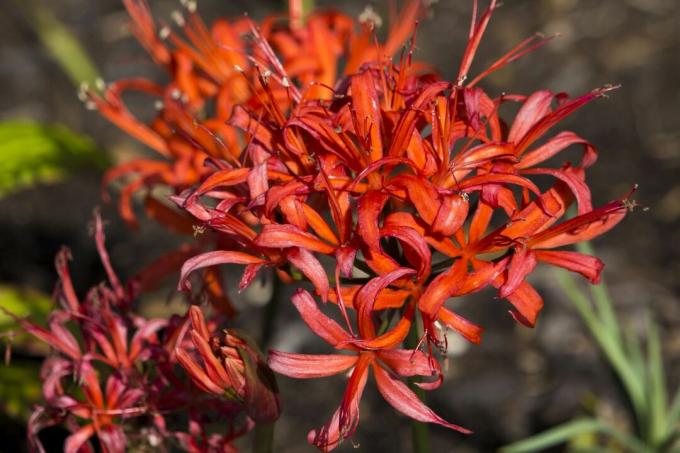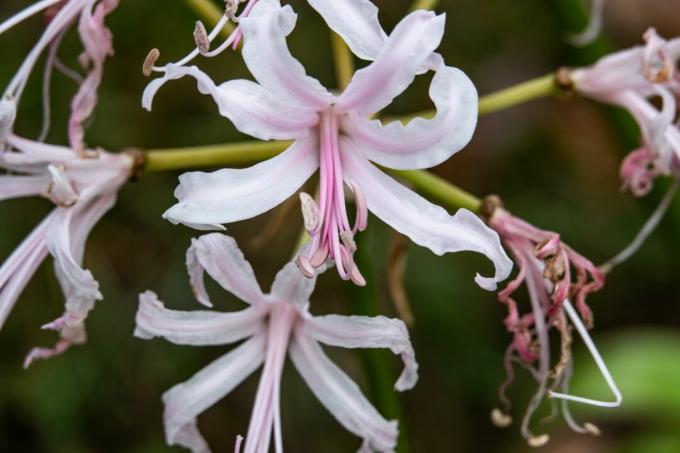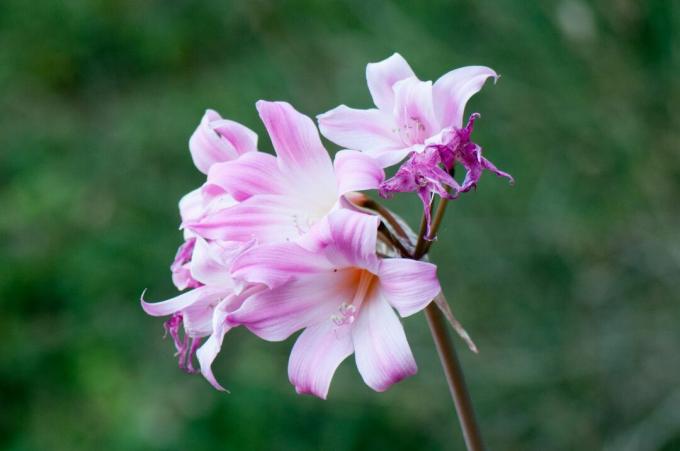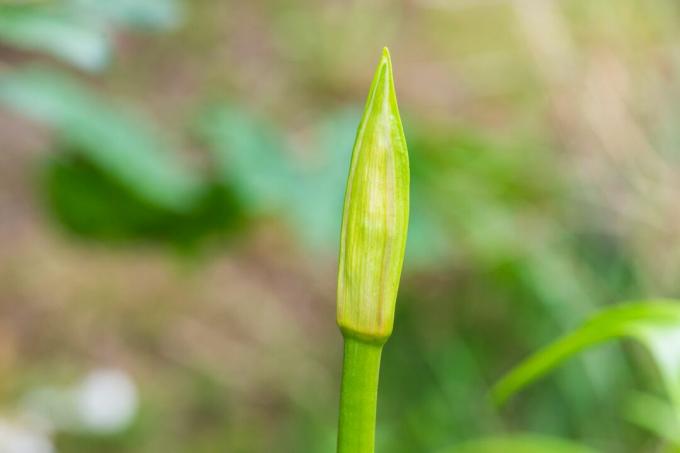the nerine, also known as the Guernsey lily, brings an exotic flair to the autumn garden with its colorful flowers.

The Guernsey lily (nerine) is a flower with a rather atypical flowering time - because it blooms in autumn and winter. But that's not the only thing that makes it so interesting as an ornamental plant: the special shape of the flowers also makes it a popular container plant.
contents
- Nerine: origin and characteristics
- The most beautiful types and varieties
- plant nerines
- Proper care of the Guernsey lily
- Is the Nerine hardy?
Nerine: origin and characteristics
The Nerines from southern Africa (nerine) form a plant genus with about 26 species - the taxonomists do not quite agree on this. They belong to the Amaryllis family (Amaryllidaceae) and are also known as Guernsey lilies. The name refers to the lily-like flowers and one of the main growing areas of the plant: the island of Guernsey. Strictly speaking, the name refers to only one species, namely the
Nerine sarniensis, but today the term is often used synonymously for various ornamental plants of this genus.nerines have simple, green leaves that remain on the plant all year round or are withdrawn, depending on the species. The leafless flower stalk emerges from the bulb in the ground, at the end of which the magnificent inflorescences sit. The flowers can have different colors and are arranged in umbels. Thus there are always up to twelve individual flowers on one shoot. nerines can grow up to 80 cm, but often remain smaller at around 30 cm. These are bulbous plant geophytes that only survive our winters protected. The late flowering period of the Guernsey lilies from September to November makes them special splashes of color in the dark season.

The most beautiful types and varieties
Not all nerinesspecies are also suitable as ornamental plants. The most common types are Nerine bowdenii and Nerine sarniensis as well as hybrids of the two. Various varieties in bright colors were also created here. Below we present a selection of popular ones nerinetypes and varieties.
Nerine bowdenii: This species usually tolerates the weather in our latitudes well and is therefore suitable as a container plant that spends the summer in the garden. It naturally blooms pink. It endures temperatures down to – 2 °C and can sometimes even hibernate in a bed under a layer of mulch in front of a warm house wall in regions with particularly mild winters.

Nerine sarniensis: This species also hardly tolerates lower temperatures and can therefore only be kept in gardens in vineyards and with winter protection in the garden. It is definitely safer to plant them in pots. It produces red flowers.
- nerine 'Alba': nerine in white
- nerine 'Bernice': Variety with bicolored flowers of white and pink
- nerine 'hera': bright pink flowers

Tip: Similar to the Nerine looks the amarine 'Bella Diva' off. However, this is a cross between nerine and amaryllis with slightly wider petals. the amarine is just as little hardy as the ones presented nerines-Species. It only tolerates temperatures just below 0 °C.

plant nerines
Planting in a pot is highly recommended because the nerine is not really hardy and the plant does not tolerate the annual digging up well. As a container plant, it can simply be moved to another place in winter. The pot does not have to be particularly large, because the Guernsey lily does not need much space for its roots. Only one specimen is ever planted individually, over time this forms daughter bulbs and thus spreads.
The right place for the bucket is rather cool in summer at 15 - 17 °C, but a maximum of 25 °C. Also, choose a sheltered spot where the nerine is not at the mercy of the weather. For example, locations in front of walls are suitable. In summer, the plant should be shaded and not in the blazing sun.
In the cold season, the nerine be protected from temperatures below 2 °C.

Tip: If your garden is in a region that is particularly warm in winter and in a sheltered location, you can also try your luck with the nerine to be cultivated in the bed all year round. Find a spot that is sheltered in winter and partially shaded in summer. If necessary, the soil should be adjusted so that it is humus, always slightly moist, but never wet. In winter you have to nerine very conscientiously protect them from the frost with leaves and bast mats and possibly prevent cold winds from reaching them.
The earth must for the nerine be rich in humus, loose and permeable. Ours is a good example Plantura organic potting soil, which can be used in the pot but can also improve the garden soil. The high humus content and the stable, loose structure offer the nerine suitable conditions. For more permeability, the earth is mixed with a third of sand. In the pot and in heavy soil, a drainage layer should also be created so that the water can drain away.
Planting takes place between April and May so that the pot with the plant can be placed outside soon after the ice saints without risk of frost. The onion is placed in the loosened soil with the narrow neck upwards. It should not be stuck deep in the ground like tulips or daffodils. It is much better if the neck protrudes a few centimeters from the substrate. When you buy it, you often get not just a single bulb, but a pot that already contains a few daughter bulbs. You can plant everything together or carefully remove one or the other bulb and plant it individually.
Proper care of the Guernsey lily
The care of the Guernsey lily is adapted to the respective season or the growth cycle:
Late summer to winter: A slow-release fertilizer is used when the leaves begin to grow. It can be applied to the plant together with a thin layer of fresh substrate. Previously, old substrate is removed. Our Plantura organic flower fertilizer for example, is specially designed for flowering plants, so your plants stay perfectly cared for and healthy. During the vegetation period and the flowering period, watering is carried out regularly, because now the nerine an evenly moist soil.

Winter to spring: After flowering, most grow nerines their leaves. Until the plants sprout again in late summer, they should not be fertilized or watered. Overwintering the bulb at around 2 °C is important to ensure that there are plenty of flowers next year. To do this, they are no longer watered after they have faded and dried at around 18 °C. After about two weeks, the leaves should be completely dead. Now the pot can be stored for at least 14 weeks at around 2 °C, for example in a shed. This process supports flowering later in the year.
Winter is also the time that nerine to repot. This is necessary every three to four years. You can remove daughter bulbs and plant them individually to get several tubs with the beautiful African lily.
if your nerine growing in the bed, October is already the right time to take care of the winter protection.
Spring to late summer: If no more frosts are to be expected from mid-May, the bucket with the nerine be put back into the open. But refrain from watering and fertilizing. A sip of water only makes sense at the end of June, because now the onion is already starting to grow its roots, even before they sprout.

Nerine does not bloom: In order for it to flower, the nerine be overwintered cold. This cooling phase induces the formation of flower buds. It must also not be too warm in summer, because from temperatures above 25 °C the flowers remain smaller or do not appear at all. It is also believed that the flowering of the nerine associated with the temperatures in late summer: Large temperature fluctuations from day to night may give the signal for the inflorescences to push.
Is the Nerine hardy?
the nerine is not really hardy in our latitudes. Some species and cultivars can tolerate cool temperatures with winter protection, however there is always a residual risk of freezing. In warmer regions with mild winters, where temperatures rarely drop below -5 °C, it is sufficient a layer of mulch as winter protection, but such measures are usually not enough in severe cold the end. It is therefore advisable that nerine to plant in pots and place them in a cool place at a maximum of 10 °C in winter.

Tip: the nerine is an extremely long-lived cut flower, as it lasts up to 14 days. You can therefore use them as excellent Christmas decorations. For that you should nerine harvest as soon as two to three flowers per pedicel have opened. It can even be stored in the refrigerator at around 4 °C.
the amaryllis he sees nerine very similar in terms of their flowers and they are also suitable as cut flowers. How you die Proper care for amaryllis, you will find out in our article.
